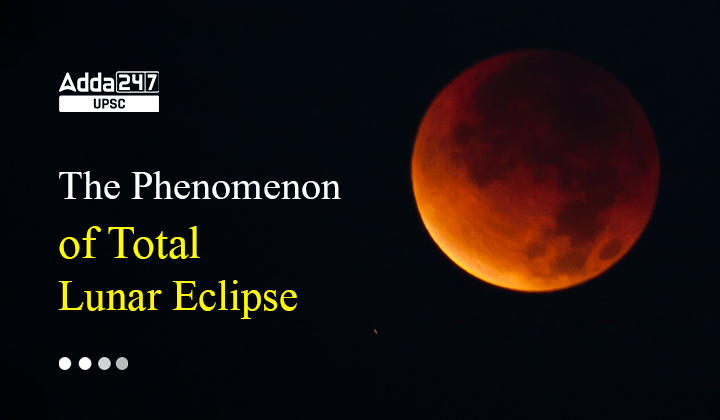Table of Contents
About The Phenomenon of Total Lunar Eclipse
- There are three different types of lunar eclipses: 1. Moon at full size and appears red; 2. Total lunar eclipse; 3. Moon is partially in shadow.
- The Phenomenon of a Total Lunar Eclipse occurs when the entire Moon falls within the darkest part of Earth’s shadow, called the umbra.
Total Lunar Eclipse: Why in news?
- Yesterday i.e. November 8, 2022, occurred the Phenomenon of a Total Lunar Eclipse.
- As per the American space agency NASA, the next total lunar eclipse will occur three years later, on March 14, 2025. However, the world will continue to witness partial lunar eclipses during that time.
Total Lunar Eclipse: What is a lunar eclipse?

- An eclipse of the Moon occurs when the Earth lies directly between the Sun and the Moon and the Moon lies in the shadow of the Earth.
- For a total lunar eclipse to happen, all three are in a straight line. This means that the Moon passes through the darkest part of the Earth’s shadow.
- A lunar eclipse happens between two to five times a year with a total lunar eclipse occurring at least two every three years.
Total Lunar Eclipse: What is the difference between a full lunar eclipse and a partial lunar eclipse?
- A full lunar eclipse is often called a blood moon because the Moon becomes a bright reddish colour.
- A partial lunar eclipse is when part of the Moon travels through the Earth’s full ‘umbral’ shadow. Only part of the Moon’s visible surface moves into the dark part of the Earth’s shadow.
- During a Partial lunar eclipse, we will only see a little over 60% of the surface of the Moon pass through Earth’s full shadow and appear red. The other part of the Moon will still appear silvery grey because sunlight is still reflecting off that part of the Moon.
Total Lunar Eclipse: Why Moon turns red during a total lunar eclipse?
- During a total eclipse, the entire Moon falls within the darkest part of Earth’s shadow, known as the umbra.
- When the Moon is within the umbra, it will turn a reddish hue.
- Lunar eclipses are sometimes called “Blood Moons” because of this phenomenon.
- During a lunar eclipse, the Moon turns red because the only sunlight reaching the Moon passes through Earth’s atmosphere.
- The more dust or clouds in Earth’s atmosphere during the eclipse, the redder the Moon will appear. It’s as if all the world’s sunrises and sunsets are projected onto the Moon.
What is Rayleigh scattering?
-
- Rayleigh scattering is a phenomenon that causes the Moon to turn red in colour.
- This is the same phenomenon that makes our sky blue and our sunsets red causes the Moon to turn red during a lunar eclipse.
- Light travels in waves, and different colors of light have different physical properties.
- Blue light has a shorter wavelength and is scattered more easily by particles in Earth’s atmosphere than red light, which has a longer wavelength.
| Important Fact: When the Sun is overhead, we see blue light throughout the sky. But when the Sun is setting, sunlight must pass through more atmosphere and travel farther before reaching our eyes. That’s why blue light from the Sun scatters away, and longer-wavelength red, orange, and yellow light pass through. During a lunar eclipse, the Moon turns red because the only sunlight reaching the Moon passes through Earth’s atmosphere. The more dust or clouds in Earth’s atmosphere during the eclipse, the redder the Moon will appear. It’s as if all the world’s sunrises and sunsets are projected onto the Moon. |
What are Tides and why do they occur?



 TSPSC Group 1 Question Paper 2024, Downl...
TSPSC Group 1 Question Paper 2024, Downl...
 TSPSC Group 1 Answer key 2024 Out, Downl...
TSPSC Group 1 Answer key 2024 Out, Downl...
 UPSC Prelims 2024 Question Paper, Downlo...
UPSC Prelims 2024 Question Paper, Downlo...
